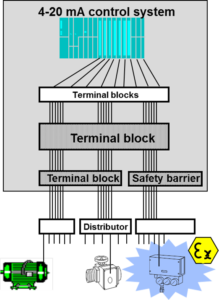History
 The “Process Industry” includes the waste water treatment, food & beverage, chemical, oil & gas, and pulp & paper industries. In the past, plant operators had to physically monitor performance values and the quality of outputs to determine the best settings on which to run production equipment. Process automation simplified this with the help of sensors at thousands of spots around the plant that collect data on temperatures, pressures, flows and so on. First generation process automation traditionally employed 4-20 mA and HART for the communication infrastructure. Often, miles of wire and many terminal blocks connected the field instruments to the central control system. It worked, but all those wires and connections made it a “bear” to maintain. PROFINET and PROFIBUS International defined a technology they called “PA” to replace all that wiring with instruments connected over a single cable.
The “Process Industry” includes the waste water treatment, food & beverage, chemical, oil & gas, and pulp & paper industries. In the past, plant operators had to physically monitor performance values and the quality of outputs to determine the best settings on which to run production equipment. Process automation simplified this with the help of sensors at thousands of spots around the plant that collect data on temperatures, pressures, flows and so on. First generation process automation traditionally employed 4-20 mA and HART for the communication infrastructure. Often, miles of wire and many terminal blocks connected the field instruments to the central control system. It worked, but all those wires and connections made it a “bear” to maintain. PROFINET and PROFIBUS International defined a technology they called “PA” to replace all that wiring with instruments connected over a single cable.
PROFIBUS PA
The Process Industry has unique requirements compared to the digital factory world. PA is designed to meet those requirements with the following features.
- PA networks can cover distances of up to 1900 meters (1000 meters for intrinsically safe).
- PA instruments receive their power over the same twisted-pair cable that delivers communication to reduce wiring.
- PA devices are “low voltage”(10 mA).
- PA instruments may be required to operate in dusty, dirty, oily or wet environments. Many are IP65 or IP67 rated.
- PA can be “intrinsically safe” to create an “Explosion proof” network for explosive environments.
- PA allows asset management and data collection to be accessed from a central location.
PA provides access to harsh environments. How do we take that information from the factory floor to a PLC/DCS to control an entire factory?
PA was coupled with PROFIBUS DP to provide a more complete solution for factory automation. PROFIBUS DP provided high speed throughput along with discrete manufacturing control so it made sense to utilize as the connection to the PLC/DCS Controller.
We will discuss PA implementation details in the follow-up section: PA Basics.
 For more information, download the full White Paper:
For more information, download the full White Paper: